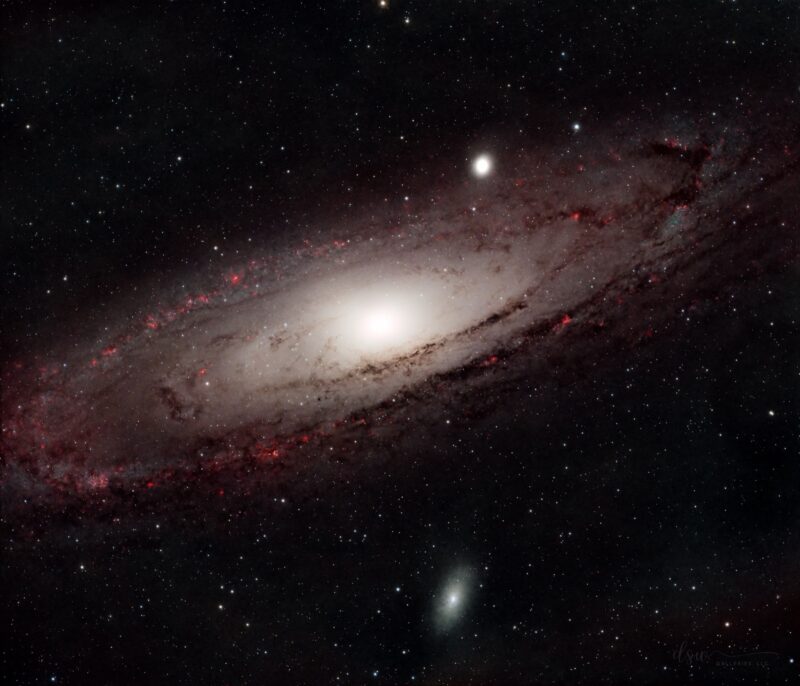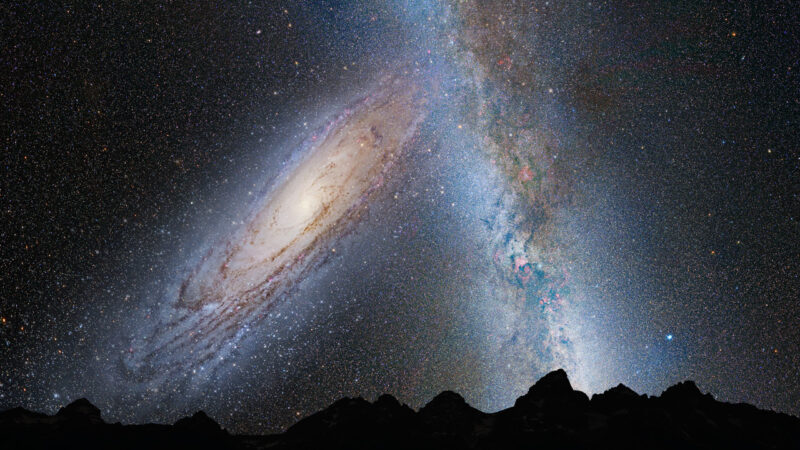
Super-fast stars from Andromeda may already be here
Could stars flung out of the nearby Andromeda galaxy already be tearing through the Milky Way?
Probably, yes, a group of astronomers said on March 12, 2024. After sifting through data from the Gaia probe, they hypothesized that some of the fastest stars speeding through the Milky Way might come from outside it.
While the researchers aren’t certain, exploration of this intriguing possibility goes on. The group – astrophysicists Lukas Gülzow, Malcolm Fairbairn and Dominik J. Schwarz – focused on extremely fast moving stars in our galaxy. These hypervelocity stars are from the fastest class of stellar object known. The first one discovered back in 1988 moves 1.5 million mph (2.4 million kph). That’s about 430 miles (700 km) a second!
To find out if they’re right, the trio built themselves a couple of galaxies, in a computer, of course:
Therefore, we simulate hypervelocity stars originating in Andromeda with initial conditions based on attributes of high-velocity stars measured in the Milky Way and a simple model for the gravitational potential of Andromeda and the Milky Way.
Gravitational potential is the amount of energy needed to move an object. The peer-reviewed Monthly Notices of the Royal Astronomical Society published their results in the April 2024 issue.
Ready to make a cosmic impact? Help us achieve our $50,000 match goal by donating today!
Andromeda is on a crash course with us!
Andromeda – a galaxy bigger than our own – is heading right for us. For each tick of the clock, it gets 70 miles closer. But don’t freak out yet.
The bulks of the Milky Way and Andromeda are still about 2.5 million light-years apart. That means these big members of our cosmic neighborhood – the Local Group – won’t really start mixing together for another 5 billion years. And that makes it something to worry about later.
Except the merger is technically already happening. Sort of. Research published in 2022 suggests the galactic halos are already touching. Galactic halos are spheres of stars, dust and dark matter that surround many, if not most, galaxies.
And they’re big. The Milky Way’s galactic halo is at least 2 million light years across. Larger Andromeda’s halo is about the same size, but lumpy.
If stars from Andromeda are inside the Milky Way – and vice versa – it’s more evidence the merger really is underway now.

How many neighboring stars are already in the Milky Way?
Since the first hypervelocity star was discovered back in 1988, several others have been detected inside the Milky Way. The question is: How many of them came from outside the galaxy? More specifically, how many are from Andromeda? It could be a handful. It could be thousands, the researchers said:
While we expect that the vast majority of hypervelocity stars in our galaxy will originate here, we expect the number of stars present from Andromeda at any one time to be between 12 and 3,910, depending upon model assumptions.
And why are they moving so mindbogglingly fast? The paper provides the current best guess:
The cause for such high kinetic energies is thought to be gravitational interactions between binary stars and the supermassive black hole in the Milky Way Center or other massive black holes in that region.
So sometimes a pair of stars gets too close to the monstrously large black hole in a galactic core. Then one of the stars gains enough velocity to fling out of its orbit. The other is captured by the black hole. The amount of momentum involved pushes the escapees to millions of miles or kilometers a second. This is like the gravitational slingshot technique used to speed up spacecraft in the solar system. The probes pass near large planets, like Jupiter, and pick up speed toward their final destinations.
When this happens with stars, it’s known as the Hills mechanism.
ID’ing stars from the Andromeda galaxy
According to the researchers, their models show some hypervelocity stars in our galaxy could have originated in Andromeda. They said:
We found that it is possible for them to reach the Milky Way. We approximated the amount of Andromeda hypervelocity stars in the Milky Way at the present time and analyzed their position and velocity properties. In addition, we discuss whether it is possible to detect them.
Possible isn’t the same as actual. The researchers needed to know the path hypervelocity stars followed to reach their current positions. This is how they did it. They began by looking for stuck hypervelocity stars:
To start with, we find that many hypervelocity stars at lower velocities are not fast enough to be able to escape the Milky Way again. Thus, a significant fraction of the hypervelocity stars arriving from Andromeda remain bound to the Milky Way gravity.
The group then compared their simulations to real data:
To assess whether hypervelocity stars from Andromeda reaching the Milky Way is ruled out by observations, we compare the simulated HVSs at present time with star data from the Gaia DR3.
Gaia is a European probe studying the distribution of stars in the Milky Way. The DR3 is the 3rd data release of Gaia’s observations. It came out in June 2022.
At least 10 stars from Andromeda should be here
So are stars traveling as fast as is possible already arriving from Andromeda? The researchers said yes, they are, or really, really should be:
We have compared the velocity directions from the simulation results with the Gaia data to find an approximately homogeneous population of velocity directions that overlaps with the simulated velocity directions.
The models said there must be at least 10 of them in the Milky Way, or even possibly thousands. We just don’t know yet. But we do know what to look for, said authors Gülzow, Fairbairn and Schwarz:
It might be possible to detect them based on their velocity and trajectory orientation. Further, it would be interesting to extend this analysis to include estimates of the stellar ages and other astrophysical information of hypervelocity stars in order to gain further insight into their origin and migration history.
Looks like yet another mystery for Gaia to explore.
Bottom line: Researchers studying the fastest stars in the Milky Way galaxy believe some may come from the nearby Andromeda galaxy. This supports the idea the two galaxies are already merging.
Source: On stellar migration from Andromeda to the Milky Way











